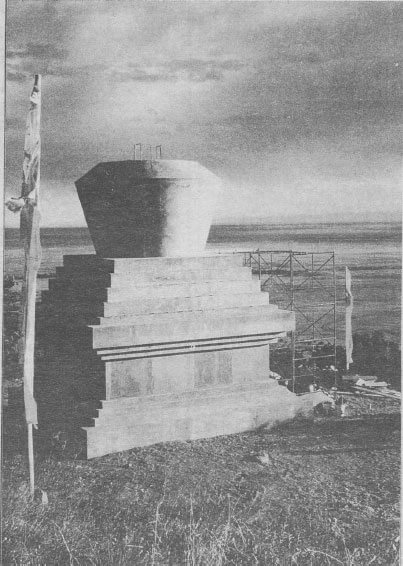| The following article is from the Autumn, 1993 issue of the Snow Lion Newsletter and is for historical reference only. You can see this in context of the original newsletter here. |

by Mark Elliott
In 1980 His Holiness the XVI Gyalwa Karmapa came to the Baca Grande, a large estate in the remote San Luis Valley of southern Colorado, at the invitation of Maurice and Hanne Strong. During his visit His Holiness had a vision that this would be a place where the rich legacy of Tibetan Buddhism could be transplanted, preserved and passed on to future generations. He foresaw the creation of a Tibetan medical center, a monastery and retreat center and an entire lay community in this inspiring location, reminiscent of many famous meditation places in his homeland. At that time the Karmapa selected and was given 200 acres of land in the Baca Grande by the Strongs so that this vision could be fulfilled.
Shortly after, the Ta Lama and a small group of Tibetans were sent to the Baca to work on the project. While significant progress was made, sadly the Ta Lama passed away, the Tibetans relocated and the project went into abeyance until 1988 when Marianne and Ngodup Burkhar were sent to revive it. A house was purchased as a practice and residential center, a road built to the land and a small group, including Maria Pelaez and Mark Elliott, assembled to work on realizing His Holiness' vision.
After visiting the Baca Grande, His Eminence Jamgon Kongtrul Rinpoche instructed us that the first step would be the creation of a forty-foot stupa on the land. Sakyamuni Buddha had instructed his students to cremate his body after his passing and place his ashes in a stupa, an architectural rendering of enlightenment, the shape of which represents the Buddha crowned and seated in meditation posture upon a lion's throne. His crown is the top of the spire, his body the vase shape, his legs the four steps of the lower terrace, and the base his throne.
There are eight kinds of stupas in the Tibetan tradition. The particular form selected for the project by His Eminence is the Tashi Gomang Stupa, or stupa of many auspicious doors, representing the 84,000 paths to enlightenment taught by the Buddha himself.
The function of a stupa is more than just symbolism, however. When a great teacher, such as His Holiness the XVI Gyalwa Karmapa, is alive, his body is known as the nirmanakaya and is not regarded as an ordinary body, but is seen as containing the very essence of awakened mind. Similarly when the teacher dies physically, his remains are considered to be a distillation of this same essence and to have enormous power, the power of complete wakefulness. The proper container for these remains is therefore a stupa, which will enshrine the aspirations, blessings and form of the teacher. The Tashi Gomang Stupa will contain relics of Sakyamuni Buddha, of His Holiness the XVI Gyalwa Karmapa, and of many highly realized Bodhisattvas. In addition one hundred thousand tsatsas, or miniature stupas, are being made by volunteers, each of which contains rolls of mantras and the names of Buddhas and Bodhisattvas, carrying heir blessings and vows to help all beings. These will be placed inside the stupa, together with many mandalas and offerings. While the outer shape is like the body, the interior holds the life force, invoking the presence and the deep goodness and infinite compassion of all Buddhas and Bodhisattvas. A statue of the XVI Gyalwa Karmapa is also being made to be placed in the base of the stupa, along with numerous decorative items and symbols.

Construction of the Tashi Gomang Stupa will accomplish many purposes. First, it will bless and consecrate the land,pacifying the negative and enriching the positive energies. In the words of Khenpo Karthar Rinpoche, who is supervising all aspects of its creation, When negativity in a particular area is allowed to accumulate, the inhabitants cannot experience good health, prosperity or the enrichment of spiritual qualities, so it creates difficulty in their lives. Building a stupa destroys and pacifies such negative energies and enriches the qualities for all inhabitants. Further, the stupa will act as a source of blessings and place of pilgrimage to people of all faiths, will give people a way to remember and reflect on the qualities of the XVI Karmapa and allow people who venerate it to join their minds with the mind of the Buddhas and Bodhisattvas.
At first the task of building such a stupa seemed to us rather intimidating, especially as we had no experience with the matter. Fortunately there is an emerging tradition of stupa building in the United States and many of the makers have been generous in sharing their knowledge and experiences. We also have the ongoing guidance of Khenpo Karthar Rinpoche and have been fortunate to receive visits from great teachers such as Bokar Rinpoche, Tenga Rinpoche and Khenpo Tsultrim Rinpoche, who have given tremendous support and inspiration. Recently Khenpo Gocha, who is exceptionally well-versed in all aspects of stupa making, has been staying with us and imparting his own detailed knowledge and understanding. All aspects of stupa building require much practice and ritual, withwhich Lama Dorje from Santa Fe and Lama Tashi from Hamburg have been particularly helpful.
The actual work on the Tashi Gomang Stupa began Thanksgiving 1989 with the cutting of the Tsok Shing, or life tree, which goes through its center. The site was blessed and offerings made by Khenpo Karthar Rinpoche and Bardor Tulku the following year, followed by the pouring of the foundation and construction of the throne. The throne was then filled with chipped juniper and manyofferings, from machine guns at the very bottom (the stupa is built on the ground of samsara) to treasure vases especially prepared for us by Tenga Rinpoche. Maria Fslaez made several trips to Nepal to commission artwork such as the umbrella and the sun and moon that form the top of the spire, and volunteers have been constantly at work making tsatsas. Finally this summer construction of the bumpa (or vase shape) was completed.
Much work on the stupa still remains to be done, however. Almost half the tsatsas have been made, and we will continue to work on them over the winter. Volunteers are always welcome and can be housed at our center. Approximately $70,000 needs to be raised to complete construction and add all the appropriate decoration, including landscaping and retaining walls. Because of themany benefits a stupa brings, it is said that contributing one's labor or financial support to the construction of a stupa brings countless individual and collective blessings in this and future lifetimes. Finally the building of the Tashi Gomang Stupa is an act of devotion to H.H. the XVI Karmapa who performed the selfless and compassionate activity of a buddha throughout his lifetime, and we invite anyone who sincerely wishes to join us in this activity to participate as fully as possible.
Donations may be sent to: Tashi Gomang Stupa, PO Box 39, Crestone, CO 81136. If you would like further information please write to us or call Mark at 7192564764 or Marianne Burkhar and Maria Pelaez at 256-4698.

